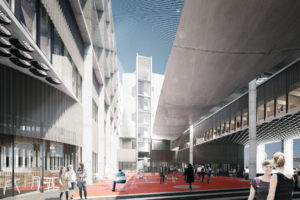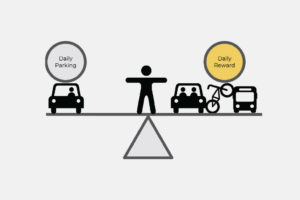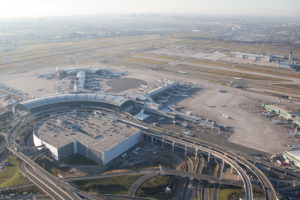By Brett Bain
Historically, things in airports around parking and transportation have until the last few years, been static. Customers generally followed three standard options for getting to the airport. They drove themselves and parked their vehicle at the airport, they took a taxi or limousine, or they were dropped off by a friend or family member.
Airports in Canada – in most cases – are non-profit organizations that operate under a lease arrangement with the federal government. They do not receive any funding from the government to operate and in fact, pay a minimum of 10% of gross revenues in tax back to the federal government. In addition, they are also required to pay property tax to the jurisdiction in which they reside. As a result, Canadian airports are very reliant on the revenue generated from non-aviation sources which consists primarily of parking, concessions within the airport and real estate revenues. These revenues are reinvested back into the airport for operational expenses and for airport infrastructure and flight development.
Like many businesses, airports have been in transition over the last few years. If we think back a bit, we can all remember that at one time telephone, internet and cable companies were all separate entities which provided a product or service to their customers. These businesses have all blended together into single entities over the last few years as technology has created opportunities for companies to enter into new markets. Parking and transportation at airports are now in the early stages of a similar transformation as transit and/or rail services begin to appear in the airport offerings. Airports are both an economic driver for their region and a reflection of the community which they serve. As cities develop new and expanded forms of transportation to serve their citizens, these are also…
By Roamy Valera
The hottest buzz word among parking leaders right now is mobility. In fact, within and outside the industry, mobility is a primary concern for those who are tasked with shaping our communities. Accountability is being placed on those who impact our ability to move about freely, easily and safely in our urban environment. How we move however, is determined by urban planning for the future. And today, as we are on the cusp of the age of the smart city and self-driving vehicles, the future of mobility is taking shape.
Mobility is about providing efficient access to essential services, employment opportunities, and entertainment and recreational opportunities. For some, that means facilitating car travel; for some it means providing transit resources, as well as first and last mile service for transit users; and for some it means providing safe and convenient pedestrian access. The benefits of providing seamless mobility are enormous: more vibrant economic development, more sustainable communities, and a better quality of life for residents and visitors.
Parking is a critical element in the mobility piece and can make or break our ability to move around our environment efficiently. An estimated 30 percent of traffic in urban areas is caused by drivers looking for parking. How we leverage innovative technology to reduce this friction is key to solving this element and will allow those accountable to our journey to better manage the curb.
Curb Management is the Key
How we manage the curb matters. When vehicles are constantly circling blocks looking for parking, they cause congestion on roadways and pose a hazardous situation for fellow drivers and pedestrians alike. Likewise, when drivers double park, they create similar hazards. So, where do we start?
Curb management begins with Transportation Demand Management (TDM). TDM is a general term describing strategies designed to increase overall…
By Nigel Bullers
Car share is transforming how people think about their daily commuting needs and that is seen on the west coast more than any of the other market; Seattle, Portland and here in Canada, Vancouver is at the epicenter of the adoption of car share. Car share has evolved over the past decade, early adopters were people that cashed in their personal cars and headfirst into car share as the only option alongside public transit. Today the users are different, many of them have multiple vehicles at home and they hold multiple car share accounts. Car share has become part of a total transportation solution for drivers. Although these new users are slightly different than the early adopters, the needs remain the same – the desire for easy parking close to destinations and pick up points, and frictionless, quick parking solutions.
Parking at the destination
In downtown urban centers some of the parking facilities will be gated, as is true in Vancouver where Pacific Centre has some 1500 spaces exactly where car share users would like to go. But in the past, car share had challenges with gated lots and lots underground where they lost the signal and would lose cars and thus inventory.
Evo Car Share and EasyPark partnered to bring car share to Pacific Centre. The process entailed enhancements to the repeaters so that vehicles would not go dark when going underground, and by devising a solution for billing for the cars going in and out of the lot. The early program worked in a very basic way, whereby drivers would simply pull a ticket, leave that ticket on the dash and then the next driver would hand that ticket to the booth attendant, who would process the ticket. Evo was billed at…
By Reachel Knight
At the periphery of downtown Calgary there is an up and coming neighbourhood literally being built from the ground up. Not so long ago this was the rough part of town avoided by the majority, but in less than a decade this city eyesore has become a hotbed for new restaurants and culturally relevant community hubs and is now called East Village.
This neighbourhood is booming. There are people and businesses moving in and infrastructure is being built to support and serve the area. Of note is one parking structure that we at the Calgary Parking Authority call 9AP, short for 9th Avenue Parkade.
Along with our partners, we excitedly broke ground this past December on an innovative, multi-use parking structure designed to stand the test of time – the design features offer the ability to be repurposed to best serve whatever needs the community has in the future, as transportation behaviours change and parking needs shift. This is a story about how the blight of Calgary is being transitioned, quite literally, into the place to be and how parking has become a conduit to developing this urban landscape.
What’s New?
East Village is home to Calgary’s new Central Library, which has been ranked as one of the top 52 Places to Go in 2019 by the New York Times. The area has a diverse mix of projects including Calgary’s first residential building with no on-site parking, the National Music Centre and hotels. Several heritage buildings have been restored to house retail and office space. East Village has evolved into a riverfront destination with parks, cafes, restaurants and scheduled community events.
East Village has been in a state of transition for a number of years. In 2007, the Calgary Municipal Land Corporation (CMLC) was incorporated as a wholly owned subsidiary…
By Brett Bain and Stephen Prati
It’s no secret that rideshare services have cut deeply into airports’ parking revenues. Airports across the US and Canada are losing millions of dollars every year as flyers turn to Uber and Lyft rather than drive themselves to airports. This represents a significant financial hit for airports because parking is so important to the bottom line. In fact, for many airports the only larger source of revenue is gate fees.
Most airports have sought ways to combat the loss of parking fees since the arrival of ridesharing services. Most attempts, though, have met with limited success. However, at Edmonton International Airport, we think we’ve found a solution.
To some extent, the challenge facing Edmonton International and other Canadian airports is more pressing than at our counterparts in the US. Unlike many American airports, Canadian airports aren’t government funded. As a result, we rely even more heavily on non-aeronautical revenue, particularly parking. We have always competed with off-airport parking facilities, but with the advent of ridesharing services we found ourselves competing for shares of a smaller pie. In short, fewer people were driving themselves to the airport and that was hitting our bottom line hard.
Edmonton International Airport has 13,500 parking stalls and serves 8.1 million customers a year. Several years ago we established Jetset, a separate organization designed to offer competitive parking products and to manage the airport’s parking resources. When Uber and Lyft arrived last spring, the airport turned to Jetset to compete with these rideshare services. As many airports across the US and Canada had already experienced, these services presented significant challenges.
Fighting Fire with Fire
The answer, in our view, was to make it more convenient (and thus more attractive) to drive to the airport and park with…
By Yona Shtern
When I write the words “parking garage,” what comes to mind?
If you had asked me ten years ago, I would have likely said the following: A large structure. Often gray and cold in the winter. Perhaps not the most inviting place, but a place I need to go to store my car for some period of time – out of necessity.
Today? It would be a completely different response. Let me explain.
Ten years ago, parking garages were essentially passive real estate. They were large structures (often built and left alone) simply waiting for use. Sometimes packed with vehicles during the day or peak evening hours, causing drivers to circle block after block in traffic looking for a garage with an open space or an acceptable price. Other times, they could be eerily empty, especially during the overnight hours.
Today, things have changed. Now, I like to think of parking garages as hubs for connected mobility services.
Virtually every vehicle coming off the assembly line now has a modem with internet connectivity. 5G promises to deliver lightning-fast bandwidth that will transform the nature of connected content and mobility services. Large brands like Google, Amazon and Apple are focused on bringing convenient, connected features and their content to drivers and passengers in connected cars across the world.
While autonomous vehicles are still years away, connected mobility is quickly becoming a reality today. The promise of a driver pulling out of the garage having their coffee ordered automatically, their parking spot reserved and paid for, the nearest gas pump or EV charger primed and ready to fuel, and their route optimized to get to their first meeting or first pitch on time is already a possibility.
Additionally, voice-powered assistants like Alexa, Siri and Google Home…
By Sidharth Malhotra
Part 1 – A Simple Guide to Understand Blockchain with a Real-World Analogy
Everyone is talking about Bitcoin these days, from your barber to your friends working the stock market. Don’t worry. This article is not about making money from Bitcoin. However, I will try to help you understand the underlying technology which makes Bitcoin work and how this concept of blockchain can be useful in the coming decades.
Historical Overview
October 31, 2008, a white paper from an anonymous person or organization named Satoshi Nakamoto was published which explained a novel approach to send money from sender to receiver directly without involving any financial intermediaries. The paper gave a name to this concept — Bitcoin. Since, Bitcoin uses some underlying concepts of cryptography, this new way of exchanging money was categorized as cryptocurrency. The only purpose of Bitcoin was for financial transactions, but researchers realized that its foundational technology can be harvested to build other secure and robust applications that can revolutionize the way current systems work. “Blockchain” was the name given to this foundational technology. Lots of technical words? Let’s simplify!
What is Blockchain? — A Real World Parking Analogy
Centralized Parking Scenario
Let’s imagine that you live in a city, which has space to accommodate 200 cars at one time (assume that there is one parking structure with a ground floor). This facility has a main gate which stays locked and is only opened when a car moves in or out. Now let’s analyze this single parking building from different points of view.
Price: Since some private company built this parking facility exclusively for parking purposes and all the maintenance and operating costs will be borne by the owner company, there will be a high fee for renting out a single parking space.
Security: If…
By Blake Laufer, Founder, MiStall Insight Inc.
I often hear about parking operations lamenting that they are unique. And they are. Very few industries are simultaneously impacted by their physical layout, special interest groups, pricing limitations, weather conditions, political agendas, and technological advancement – all at the same time.
Subsequently, with so many moving parts it’s difficult for parking operations to measure their success. How is my operation doing? Are we profitable? Are we serving our parkers fairly? Am I succeeding as a manager?
We are not alone. Many other industries have similar challenges to parking, and so instead of examining what makes parking different, we should look at how parking is the same. Furthermore, we can learn from other industries how they measure success, and we can adapt those measures to ourselves.
Supply and Demand: It’s the Law
As you’re probably aware, the Law of Supply and Demand works to balance the amount of supply (product available from manufacturers) with demand (amount of product desired by consumers). When prices are higher consumers buy less and manufacturers produce less; when prices are lower consumers buy more and manufacturers produce more.
The Laws of Supply and Demand can be distorted by various factors. One such distortion occurs in the fixed-supply industry where there supply of product is scarce, like parking. In parking the “manufacturer” is the parking operation, and the parking operation cannot easily change the supply of parking spaces in the short-term. (Over the long-term it’s possible to change your supply – build a new garage, for example, but over the short-term we have roughly the same number of parking spaces available to be sold every day.)
Other fixed-supply industries include airlines (with a fixed number…
BY PAULO NUNES-UENO
Parking is out. Mobility is in.
Strolling the vendor booths at the Canadian Parking Association conference in Toronto this year makes that clear. We are all rebranding, it seems. Including me. The group I started at Seattle’s DOT, called the Transit and Mobility Division, manages transit, bikeshare, carshare, and of course, parking. Now as a consultant, I help clients retool their campus and city parking into ‘mobility’ services.
Mobility. Such a sweet word. If you close your eyes, you can almost hear…the future! Unfortunately, the transportation and ecological challenges we face won’t be solved through slogans. And the stakes couldn’t be higher. Get ‘mobility’ right and we stand a chance against climate change. Getting it wrong also spells extinction for those in the parking–I mean mobility–business.
Technology changes and growth make real adaptations all the more urgent. Re-urbanization is transforming cities throughout North America. Companies that a generation ago would have happily sprawled in suburban office parks are packing into downtown skyscrapers. Witness the new Amazon HQs headed to NYC and Washington DC. We can actually see this change happening inside our workplaces. The typical office from the early 2000’s housed 3 or 4 people per 1000 square feet. Today interior designers and architects with open offices and shared workstation have managed to more than double that.
Too bad transportation can’t claim anything close. None of the innovations to date increase the capacity of roadways or parking lots very much.
Driverless cars, the next big ‘innovation’ afoot, will actually make matters worse. Though we don’t know when autonomous vehicles are coming exactly, we can be sure they will impact the urban landscape. How? Because we have experience with services that drop people off at their destination and keep going. They’re called taxis….
By Jennifer Mucha
Toronto Pearson is Canada’s largest airport, and the ninth-busiest airport in North America, moving nearly 50 million annual passengers from security checkpoint to gate to more than 170 destinations around the world. The airport has a mandate to put passengers at the heart of every decision, and as a result was recently recognized by the Airports Council International as the Airport Service Quality best large airport in North America. Believing that the passenger experience starts long before take-off, Toronto Pearson is using technology and analytics to build a diverse and creative transportation offering that ensures travellers have an end-to-end experience tailored to their individual needs, while keeping future aviation demand in its sights.
Toronto Pearson has come a long way from its origins in a farmer’s field in the village of Malton in 1939. The airport grounds now stretch from Mississauga in the west to the city of Toronto in the east and south, and to Brampton in the north. At the heart of three municipalities and close to the 400-series highways, it goes without saying that Toronto Pearson sees high vehicle traffic from passengers, meeters, greeters and employees.
Integrating Parking and Transportation
With nearly 50 million annual passengers, as well as an airport employee community of almost 50,000 workers, efficient transportation into and out of the airport is critical to the success of the operation. An intricate network of municipal transit providers, ground transportation operators and the airport’s own Parking and Ground Transportation business unit work together with a common goal: to ensure that transportation at the airport is integrated, provides a diverse and appropriate range of services and contributes to the airport’s passengers-first mandate.
Achieving that goal is no small feat. Toronto Pearson’s three covered garages and two outdoor lots represent Canada’s…















